Assessment of Urban Green Space Based on Bio-Energy Landscape Connectivity: A Case Study on Tongzhou District in Beijing, China
Abstract
1. Introduction
2. Materials and Methods
2.1. Study Area
2.2. Data Preparation
2.3. Overall Framework
- The bio-energy index (Mcal/year) describes the energy which an ecological system has to dissipate in the environment to maintain its level of metastability [37].
- To identify the bio-energy landscape unit (BELU) level of landscape connectivity, the bio-energy fluxes (Mcal/year) exchanged among adjacent BELUs was calculated. A BELU is an higher hierarchical level than the landscape mosaic, defined as a portion of landscape with variable homogeneity characteristics surrounded by recognizable and significant barriers for bio-energy fluxes [28,37].
- The dMtot index (%) indicates the connectivity importance of each patch. That is, a patch with a high dMtot value makes an enormous contribution of landscape connectivity to the overall ecosystem.
2.4. Bio-Energy Graph
2.5. Alternative Scenarios Development
2.6. NUAs Assessment
3. Results
3.1. Spatial Dynamics of Bio-Energy
3.2. Detecting the Best Land-Use Scenarios
3.3. Identification and Priority Ranking of Critical Areas from NUAs
- Low Priority Zones were the zero ESV_B areas. These zones consisted of artificial surface patches in NUAs. For example, the patches numbered 42, 68, 76, 323, 324, and 326 in Figure 8 are some buildings in a park. High Priority Zones surrounded most of the zones. Low Priority Zones should be reasonably utilized by inhabitants living around here. Current non-green patches to be alternatively changed to urban can be detected from these zones.
- Medium Priority Zones with zero dMtot values but nonzero ESV_B values were caused by the isolation of urban fabric and major road networks. For instance, No. 358 and 311 patches in Figure 8 are cut off by the Sixth Ring Road thus lost the connectivity factor (dMtot index). Most districts of the zones were isolated patches. To increase landscape connectivity within Medium Priority Zones, we should add some new elements like ecological corridors to the zones in current urban patches surrounding these zones, which can best improve the landscape quality.
- High Priority Zones were regions where green space was concentrated and contiguous. From a nature conservation and sustainability perspective, High Priority Zones were found to be the most important areas devoting to the overall city ecosystem. Some well-designed parks were included in the zones, such as Canal Forest Park in Figure 8. These zones were the priority protected districts for decision-makers. In the case of urbanization and related land-use change programs (e.g., road building, house construction) occurring in these zones, accurate environmental assessment should be implemented to avoid decreasing landscape connectivity.
4. Discussion
4.1. Impacts of Urbanization on Natural Ecosystems
4.1.1. Landscape Fragmentation Caused by Urbanization
4.1.2. Spatial Reduction of Green Space in Response to Urbanization
4.2. The Importance of Green Space Beside the River Network
4.3. Contributions to the Literature
5. Conclusions
- Landscape fragmentation is ubiquitous in the rapid urbanization areas resulting from the urban sprawl;
- Rapid urbanization has reduced green spaces;
- The river ecology network is a significant area for landscape connectivity;
- Urban planners and biologists can apply our method to evaluate urban green space and identify conservation or restoration priority areas, and thus help decision-makers to achieve a sustainable development strategy in a rapidly urbanizing area.
Supplementary Materials
Author Contributions
Funding
Acknowledgments
Conflicts of Interest
References
- Rana, M.M.P. Urbanization and sustainability: Challenges and strategies for sustainable urban development in Bangladesh. Environ. Dev. Sustain. 2011, 13, 237–256. [Google Scholar] [CrossRef]
- Sandström, U.G. Green infrastructure planning in urban Sweden. Plan. Pract. Res. 2002, 17, 373–385. [Google Scholar] [CrossRef]
- Heymans, A.; Breadsell, J.; Morrison, G.M.; Byrne, J.J.; Eon, C. Ecological Urban Planning and Design: A Systematic Literature Review. Sustainability 2019, 11, 3723. [Google Scholar] [CrossRef]
- Champion, T.; Hugo, G.; Zlotnik, H. World Urbanization: Trends and Prospects. In New Forms of Urbanization; Routledge: Abingdon, UK, 2018; pp. 43–64. [Google Scholar]
- Wu, H.; Liu, L.; Yu, Y.; Peng, Z. Evaluation and planning of urban green space distribution based on mobile phone data and two-step floating catchment area method. Sustainability 2018, 10, 214. [Google Scholar] [CrossRef]
- Roppongi, H. Tokyo, Japan: Low-carbon policy for buildings. In Urbanization and Climate Co-Benefits: Implementation of Win-Win Interventions in Cities; CRC Press: Boca Raton, FL, USA, 2017; pp. 125–129. ISBN 9781317357711. [Google Scholar]
- Morley, P.M. Urban Forestry in North York. For. Chron. 2014, 64, 360–364. [Google Scholar] [CrossRef][Green Version]
- Capotorti, G.; Mollo, B.; Zavattero, L.; Anzellotti, I.; Celesti-Grapow, L. Setting priorities for urban forest planning. A comprehensive response to ecological and social needs for the metropolitan area of Rome (Italy). Sustainability 2015, 7, 3958–3976. [Google Scholar] [CrossRef]
- Breuste, J.H. Decision making, planning and design for the conservation of indigenous vegetation within urban development. Landsc. Urban Plan. 2004, 68, 439–452. [Google Scholar] [CrossRef]
- Bolund, P.; Hunham, S. Ecosystem services in urban areas. Ecol. Econ. 1999, 29, 293–301. [Google Scholar] [CrossRef]
- Tratalos, J.; Fuller, R.A.; Warren, P.H.; Davies, R.G.; Gaston, K.J. Urban form, biodiversity potential and ecosystem services. Landsc. Urban Plan. 2007, 83, 308–317. [Google Scholar] [CrossRef]
- Haines-Young, R.; Potschin, M. Common International Classification of Ecosystem Services (CICES): Consultation on Version 4, August–December 2012; Report to the European Environment Agency; BSS/07/007; European Environment Agency: København, Denmark, 2013. Available online: www.cices.eu (accessed on 8 September 2019).
- Locosselli, G.M.; Camargo, E.P.; Moreira, T.C.L.; Todesco, E.; de Andrade, M.F.; André, C.D.S.; André, P.A.; Singer, J.M.; Ferreira, L.S.; Saldiva, P.H.N.; et al. Effects of climate and air pollution on the growth of urban trees. In Proceedings of the 10th World Dendro Conference, Thimphu, Bhutan, 2–22 June 2018; Elsevier: Amsterdam, The Netherlands, 2018; Volume 666, pp. 652–661. [Google Scholar]
- Li, X.; Zhou, W.; Ouyang, Z.; Xu, W.; Zheng, H. Spatial pattern of greenspace affects land surface temperature: Evidence from the heavily urbanized Beijing metropolitan area. China. Landsc. Ecol. 2012, 27, 887–898. [Google Scholar] [CrossRef]
- Islam, M.N.; Rahman, K.S.; Bahar, M.M.; Habib, M.A.; Ando, K.; Hattori, N. Pollution attenuation by roadside greenbelt in and around urban areas. Urban For. Urban Green. 2012, 11, 460–464. [Google Scholar] [CrossRef]
- Zhang, B.; di Xie, G.; Li, N.; Wang, S. Effect of urban green space changes on the role of rainwater runoff reduction in Beijing, China. Landsc. Urban Plan. 2015, 140, 8–16. [Google Scholar] [CrossRef]
- Kong, F.; Yin, H.; Nakagoshi, N. Using GIS and landscape metrics in the hedonic price modeling of the amenity value of urban green space: A case study in Jinan City, China. Landsc. Urban Plan. 2007, 79, 240–252. [Google Scholar] [CrossRef]
- Pelorosso, R.; Gobattoni, F.; Geri, F.; Monaco, R.; Leone, A. Evaluation of Ecosystem Services related to Bio-Energy Landscape Connectivity (BELC) for land use decision making across different planning scales. Ecol. Indic. 2016, 61, 114–129. [Google Scholar] [CrossRef]
- Nesticò, A.; Guarini, M.R.; Morano, P.; Sica, F. An economic analysis algorithm for urban forestry projects. Sustainability 2019, 11, 314. [Google Scholar] [CrossRef]
- Nesticò, A.; Sica, F. The sustainability of urban renewal projects: A model for economic multi-criteria analysis. J. Prop. Invest. Finance 2017, 35, 397–409. [Google Scholar] [CrossRef]
- Guo, S.; Saito, K.; Yin, W.; Su, C. Landscape connectivity as a tool in green space evaluation and optimization of the Haidan District, Beijing. Sustainability 2018, 10, 1979. [Google Scholar] [CrossRef]
- Kabisch, N.; Qureshi, S.; Haase, D. Human-environment interactions in urban green spaces—A systematic review of contemporary issues and prospects for future research. Environ. Impact Assess. Rev. 2015, 50, 25–34. [Google Scholar] [CrossRef]
- Cheng, F.; Liu, S.; Hou, X.; Zhang, Y.; Dong, S. Response of bioenergy landscape patterns and the provision of biodiversity ecosystem services associated with land-use changes in Jinghong County, Southwest China. Landsc. Ecol. 2018, 33, 783–798. [Google Scholar] [CrossRef]
- Daily, G.C.; Polasky, S.; Goldstein, J.; Kareiva, P.M.; Mooney, H.A.; Pejchar, L.; Ricketts, T.H.; Salzman, J.; Shallenberger, R. Ecosystem services in decision making: Time to deliver. Front. Ecol. Environ. 2009, 7, 21–28. [Google Scholar] [CrossRef]
- Bagstad, K.J.; Johnson, G.W.; Voigt, B.; Villa, F. Spatial dynamics of ecosystem service flows: A comprehensive approach to quantifying actual services. Ecosyst. Serv. 2013, 4, 117–125. [Google Scholar] [CrossRef]
- Boumans, R.; Altman, I.; Kaufman, L.; van den Belt, M. Multiscale Integrated Modeling of Ecosystems Services (MIMES): Simulating interactions of coupled human and natural systems. Ecosyst. Serv. 2015. [Google Scholar] [CrossRef]
- Ng, C.N.; Xie, Y.J.; Yu, X.J. Integrating landscape connectivity into the evaluation of ecosystem services for biodiversity conservation and its implications for landscape planning. Appl. Geogr. 2013, 42, 1–12. [Google Scholar] [CrossRef]
- Pelorosso, R.; Gobattoni, F.; Geri, F.; Leone, A. PANDORA 3.0 plugin: A new biodiversity ecosystem service assessment tool for urban green infrastructure connectivity planning. Ecosyst. Serv. 2017, 26, 476–482. [Google Scholar] [CrossRef]
- Pelorosso, R.; Gobattoni, F.; Geri, F.; Monaco, R.; Leone, A. Bio-Energy Connectivity and Ecosystem Services. An assessment by PANDORA3.0 model for land use decision making. J. Land Use Mobil. Environ. 2014. [Google Scholar] [CrossRef]
- Zhang, H.Z.; Li, H.; Wang, Z.; Zhou, L.D. Accumulation characteristics of copper and cadmium in greenhouse vegetable soils in Tongzhou district of Beijing. Procedia Environ. Sci. 2011, 10, 289–294. [Google Scholar] [CrossRef]
- Beijing Municipal Government. Urban Master Plan of Beijing (2016–2035); Beijing Municipal Government: Beijing, China, 2017; p. 86.
- Li, Y. Beijing’s future mapped out for two decades. China Daily, 18 October 2017; 14. [Google Scholar]
- Xin, W. Beijing to launch second phase of sub-center construction. China Daily, 14 January 2019. [Google Scholar]
- Manager, L. ArcGIS 10. 2 for Desktop; ESRI: Redlands, CA, USA, 2011. [Google Scholar]
- Pelorosso, R.; Gobattoni, F. PANDORA 3.0 Model Setup; PANDORA: Copenhagen, Denmark, 2016. [Google Scholar]
- QGIS Development Team. QGIS Geographic Information System; Open Source Geospatial Foundation Project; OSGeo: Chicago, IL, USA, 2013. [Google Scholar]
- Gobattoni, F.; Pelorosso, R.; Lauro, G.; Leone, A.; Monaco, R. A procedure for mathematical analysis of landscape evolution and equilibrium scenarios assessment. Landsc. Urban Plan. 2011, 103, 289–302. [Google Scholar] [CrossRef]
- Bultheel, A.; Cools, R.; Butcher, J.C. Numerical Methods for Ordinary Differential Equations: Early Days; John Wiley & Sons: Hoboken, NJ, USA, 2010; ISBN 1119121507. [Google Scholar]
- Gobattoni, F.; Groppi, M.; Monaco, R.; Pelorosso, R. New Developments and Results for Mathematical Models in Environment Evaluations. Acta Appl. Math. 2014, 132, 321–331. [Google Scholar] [CrossRef]
- Gobattoni, F.; Lauro, G.; Monaco, R.; Pelorosso, R. Mathematical models in landscape ecology: Stability analysis and numerical tests. Acta Appl. Math. 2013, 125, 173–192. [Google Scholar] [CrossRef]
- Tannier, C.; Foltête, J.C.; Girardet, X. Assessing the capacity of different urban forms to preserve the connectivity of ecological habitats. Landsc. Urban Plan. 2012, 105, 128–139. [Google Scholar] [CrossRef]
- Tischendorf, L.; Fahrig, L. How should we measure landscape connectivity? Landsc. Ecol. 2000, 15, 633–641. [Google Scholar] [CrossRef]
- Adriaensen, F.; Chardon, J.P.; De Blust, G.; Swinnen, E.; Villalba, S.; Gulinck, H.; Matthysen, E. The application of “least-cost” modelling as a functional landscape model. Landsc. Urban Plan. 2003, 64, 233–247. [Google Scholar] [CrossRef]
- Gao, J.; Li, S. Detecting spatially non-stationary and scale-dependent relationships between urban landscape fragmentation and related factors using Geographically Weighted Regression. Appl. Geogr. 2011, 31, 292–302. [Google Scholar] [CrossRef]
- Fan, C.; Myint, S. A comparison of spatial autocorrelation indices and landscape metrics in measuring urban landscape fragmentation. Landsc. Urban Plan. 2014, 121, 117–128. [Google Scholar] [CrossRef]
- Gandy, M. Landscapes of disaster: Water, modernity, and urban fragmentation in Mumbai. Environ. Plan. A 2008, 40, 108–130. [Google Scholar] [CrossRef]
- Zhou, X.; Wang, Y.C. Spatial-temporal dynamics of urban green space in response to rapid urbanization and greening policies. Landsc. Urban Plan. 2011, 100, 268–277. [Google Scholar] [CrossRef]
- Byomkesh, T.; Nakagoshi, N.; Dewan, A.M. Urbanization and green space dynamics in Greater Dhaka, Bangladesh. Landsc. Ecol. Eng. 2012, 8, 45–58. [Google Scholar] [CrossRef]
- Yang, J.; Sun, J.; Ge, Q.; Li, X. Assessing the impacts of urbanization-associated green space on urban land surface temperature: A case study of Dalian, China. Urban For. Urban Green. 2017, 22, 1–10. [Google Scholar] [CrossRef]
- Kabisch, N.; Haase, D. Green spaces of European cities revisited for 1990–2006. Landsc. Urban Plan. 2013, 110, 113–122. [Google Scholar] [CrossRef]
- Xu, L.; You, H.; Li, D.; Yu, K. Urban green spaces, their spatial pattern, and ecosystem service value: The case of Beijing. Habitat Int. 2016, 56, 84–95. [Google Scholar] [CrossRef]
- Yang, J.; Guan, Y.; Xia, J.C.; Jing, C.; Li, X. Spatiotemporal variation characteristics of green space ecosystem service value at urban fringes: A case study on Ganjingzi District in Dalian, China. Sci. Total Environ. 2018, 639, 1453–1461. [Google Scholar] [CrossRef] [PubMed]
- Everard, M.; Moggridge, H.L. Rediscovering the value of urban rivers. Urban Ecosyst. 2012, 15, 293–314. [Google Scholar] [CrossRef]
- Jane, S.; Taylor, M.P.; Patrick, M. Why rehabilitate urban river systems? Area 2015, 38, 312–325. [Google Scholar]
- McGarigal, K.; Marks, B.J. FRAGSTATS: Spatial pattern analysis program for quantifying landscape structure. Gen. Tech. Rep. US Dep. Agric. For. Serv. 1995, 351. [Google Scholar] [CrossRef]
- Saura, S.; Torné, J. Conefor Sensinode 2.2: A software package for quantifying the importance of habitat patches for landscape connectivity. Environ. Model. Softw. 2009, 24, 135–139. [Google Scholar] [CrossRef]
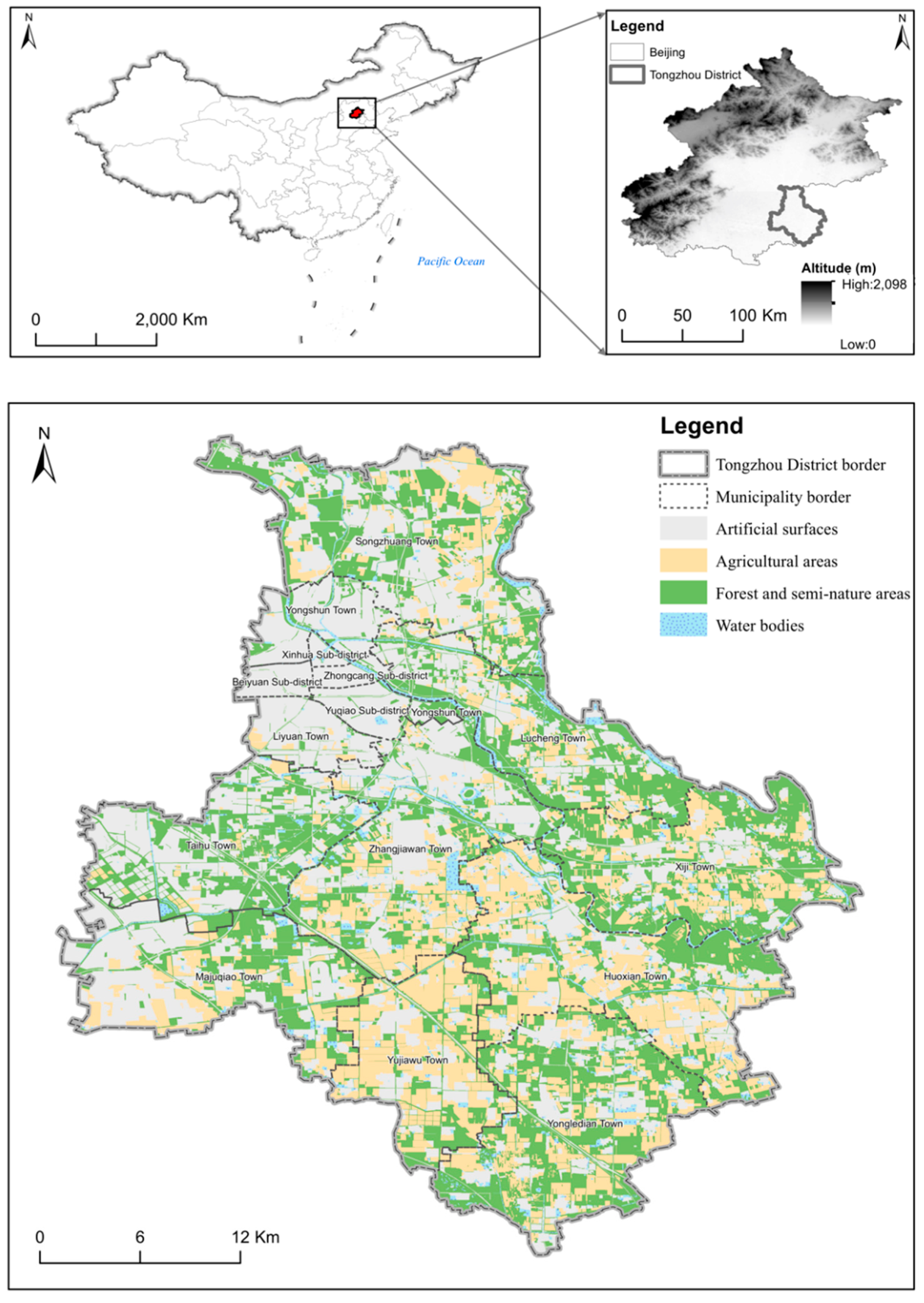
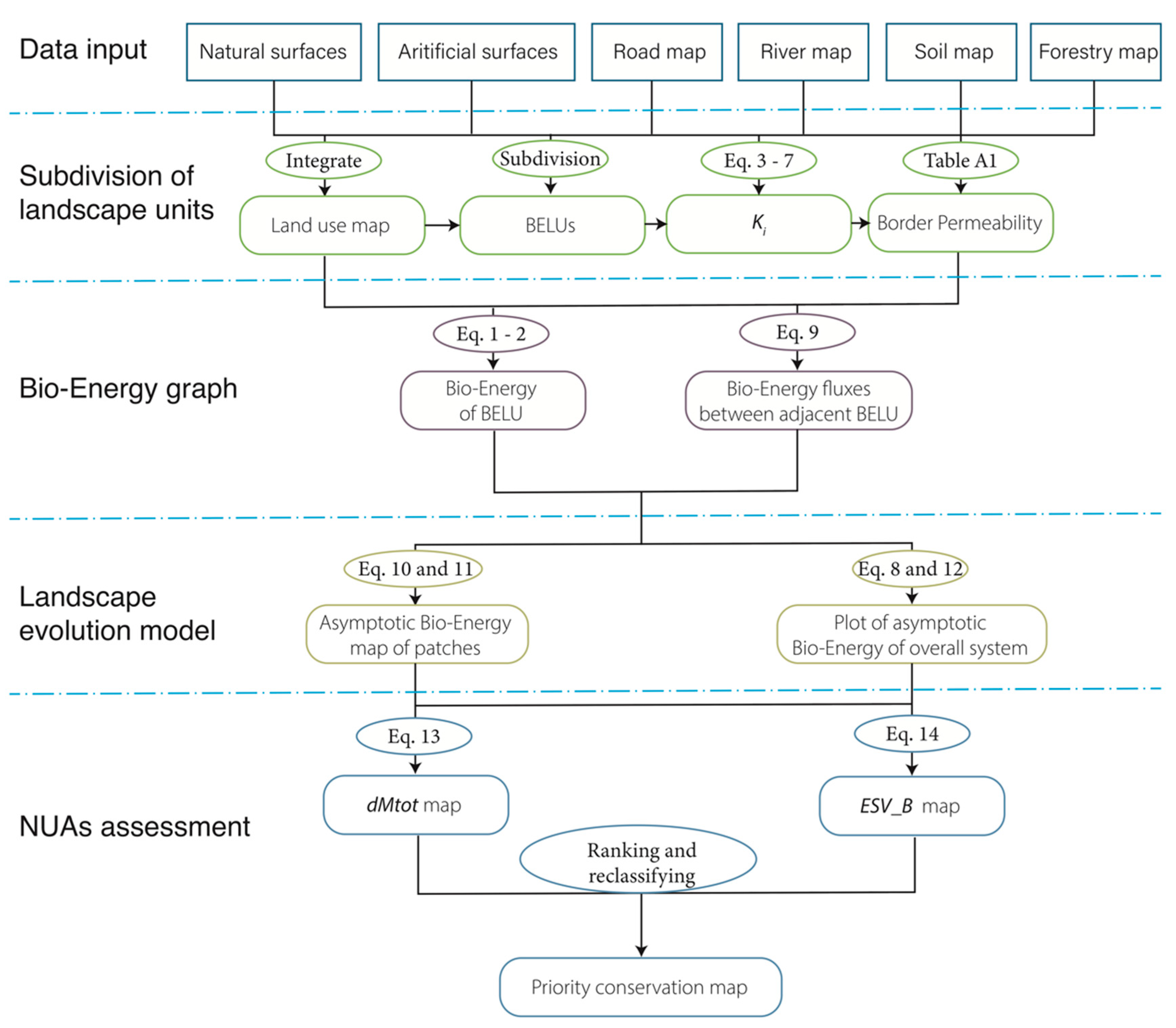
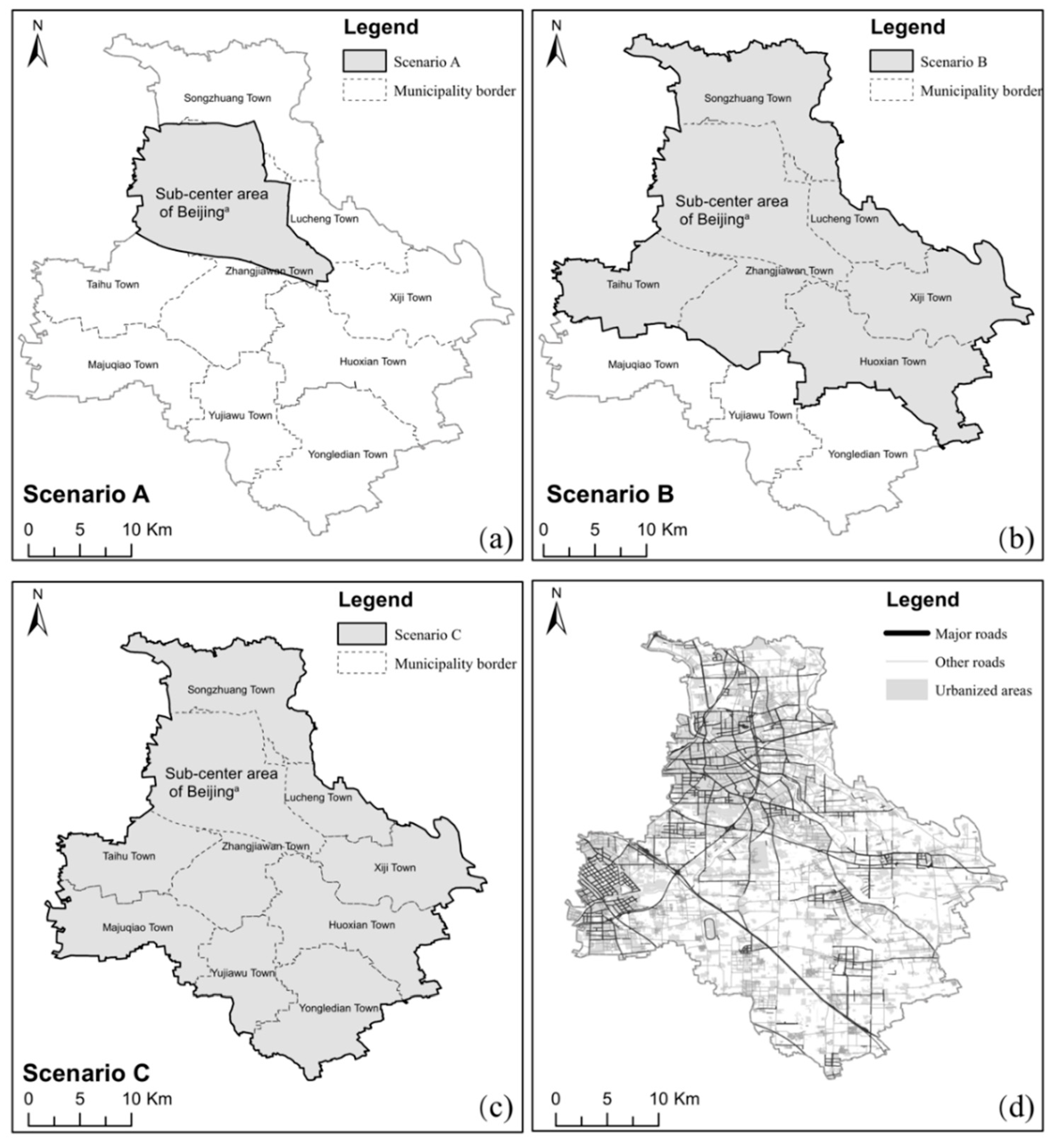
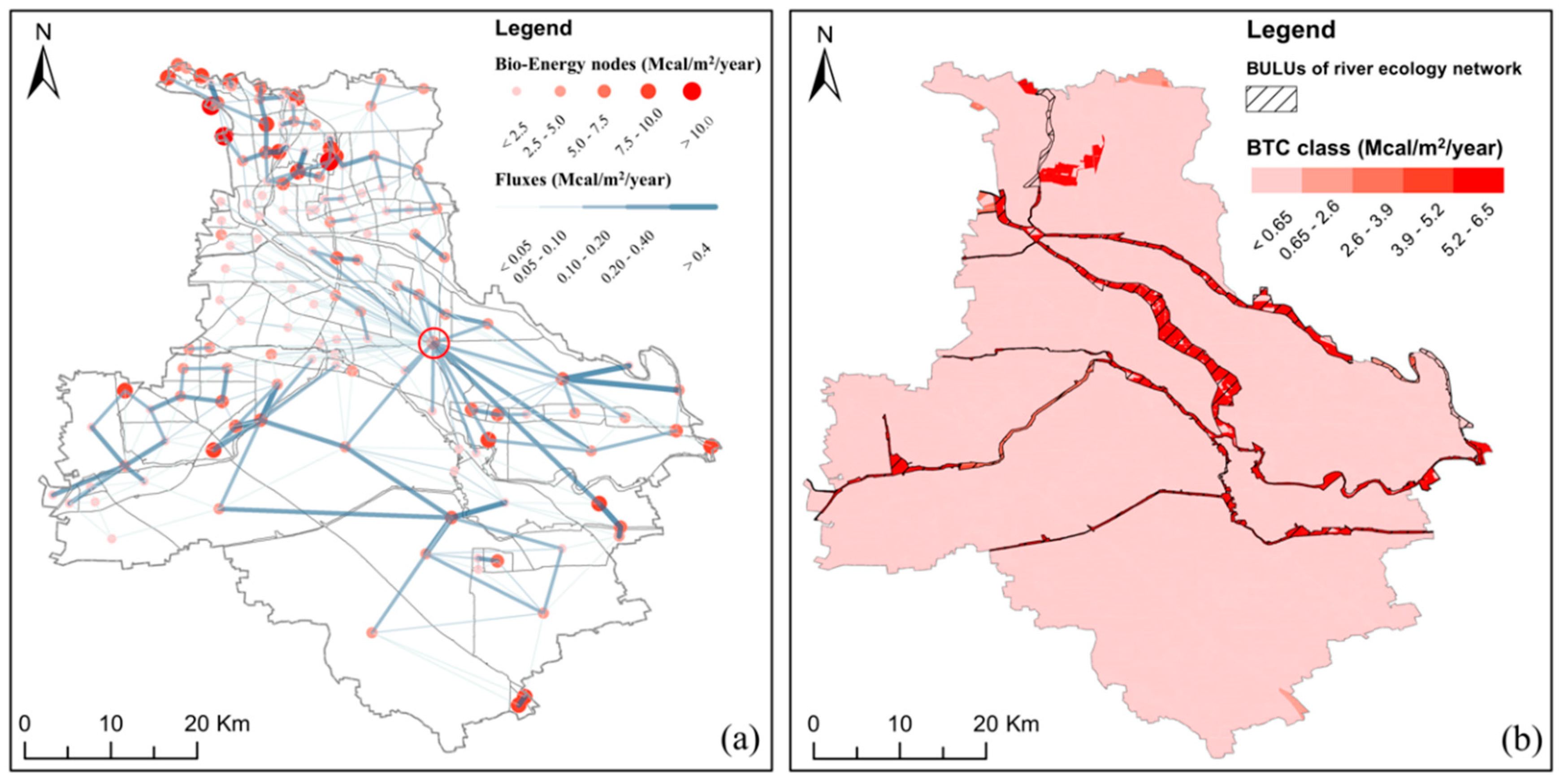
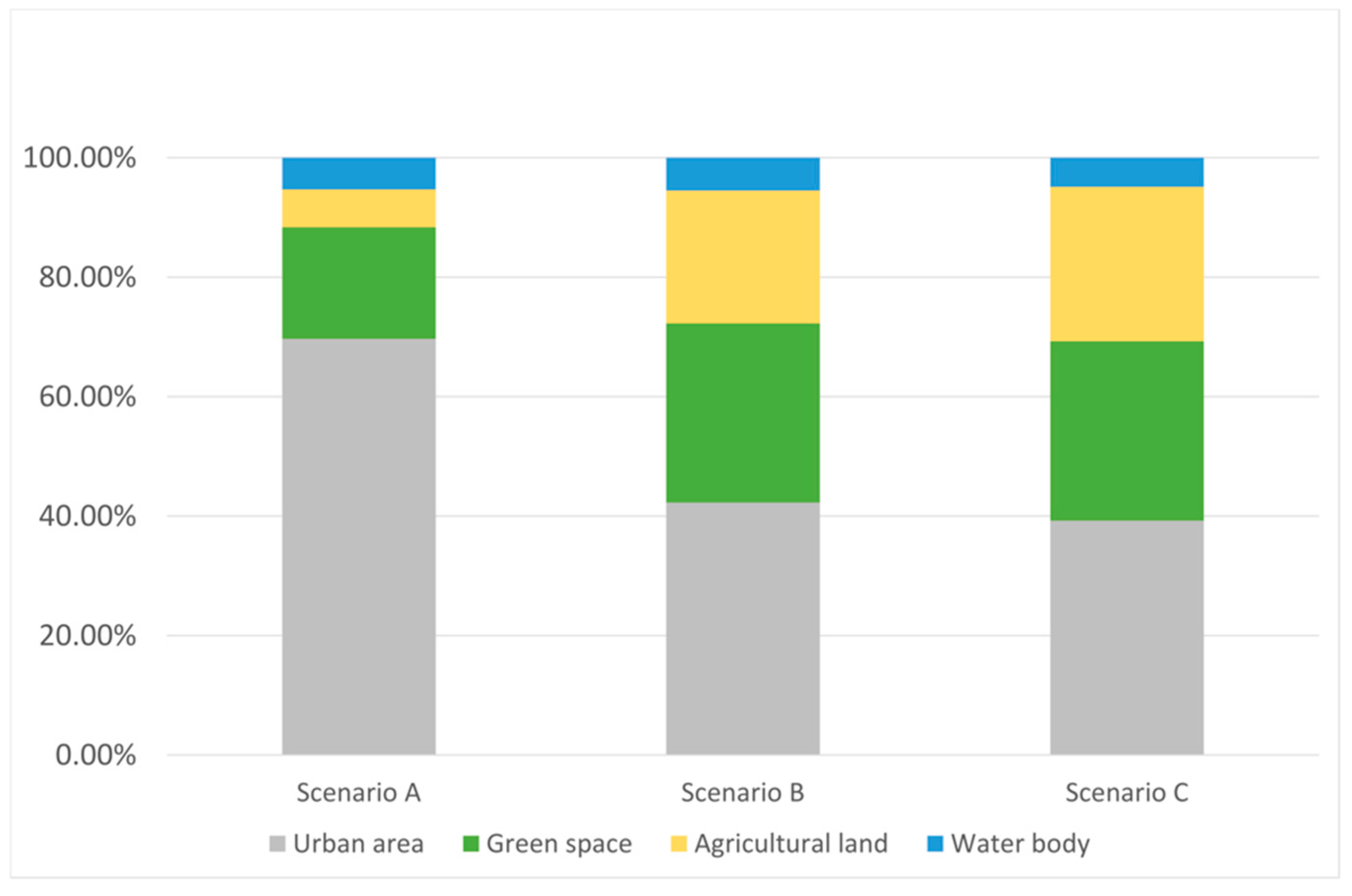

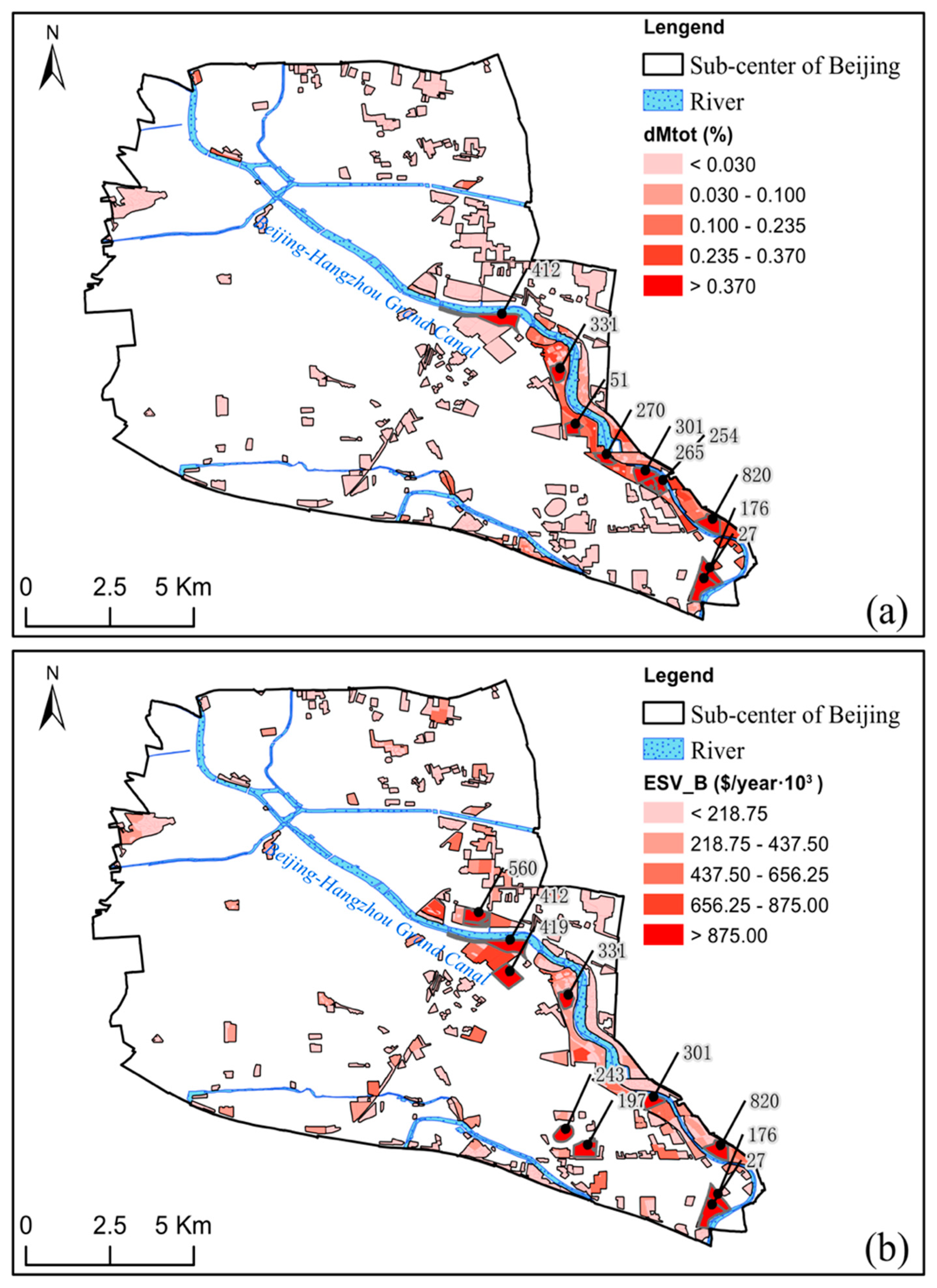
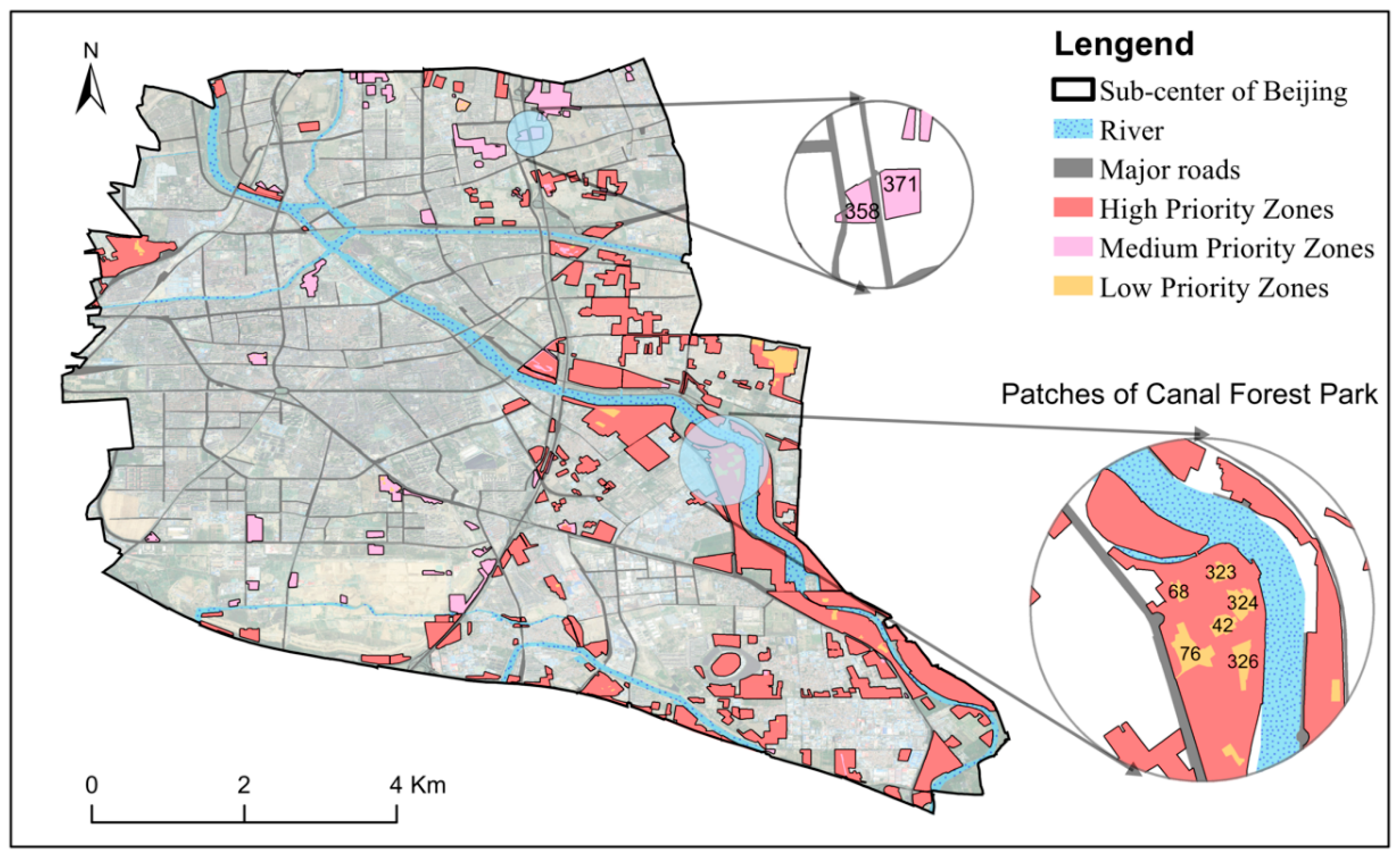
| Date | Data Source | Data Type | Description |
|---|---|---|---|
| Forest resource inventory database | Beijing Tongzhou Forestry Bureau | Polygon shape file | Forest location, forest types, forest conservation types (ranging from non-conservation (grade IV) to highest conservation (grade I)), vegetation coverage, forest origins, agricultural area location, water body location |
| Artificial surfaces land-use database | Beijing Qianfan Shijing Technology Company | Polygon shape file | Building types and location, road types and location, railway types and location |
| Soil map | Beijing Tongzhou Forestry Bureau | Polygon shape file | Soil types, textures, thickness |
| Administrative data | Beijing Municipal Bureau of Land and Resources Tongzhou Branch | Polygon shape file | Data of state, province, city, county (district), town (sub-district) and village |
| CORINE CODE | Land Cover Type | Number of Patches | Area (m2) |
|---|---|---|---|
| 1111 | Continuous and dense urban fabric | 4668 | 324,150,637.51 |
| 1221 | Road networks | 1250 | 26,868,353.11 |
| 124 | Airport | 1 | 4,477,751.51 |
| 2121 | Permanently irrigated arable land | 3290 | 207,319,363.56 |
| 2122 | Nurseries in permanently irrigated land | 500 | 26,851,685.69 |
| 311 | Broad-leaved forest | 19,062 | 204,586,571.14 |
| 312 | Coniferous forest | 5197 | 19,749,775.19 |
| 313 | Mixed forest | 1219 | 23,997,610.95 |
| 321 | Natural grasslands | 441 | 8,793,494.75 |
| 322 | Moors and heathlands | 961 | 5,696,854.04 |
| 332 | Bare rocks | 191 | 7,271,856.32 |
| 333 | Sparsely vegetated areas | 127 | 1,900,278.29 |
| 5111 | Rivers and streams | 1435 | 44,384,035.96 |
© 2019 by the authors. Licensee MDPI, Basel, Switzerland. This article is an open access article distributed under the terms and conditions of the Creative Commons Attribution (CC BY) license (http://creativecommons.org/licenses/by/4.0/).
Share and Cite
Wanghe, K.; Guo, X.; Luan, X.; Li, K. Assessment of Urban Green Space Based on Bio-Energy Landscape Connectivity: A Case Study on Tongzhou District in Beijing, China. Sustainability 2019, 11, 4943. https://doi.org/10.3390/su11184943
Wanghe K, Guo X, Luan X, Li K. Assessment of Urban Green Space Based on Bio-Energy Landscape Connectivity: A Case Study on Tongzhou District in Beijing, China. Sustainability. 2019; 11(18):4943. https://doi.org/10.3390/su11184943
Chicago/Turabian StyleWanghe, Kunyuan, Xinle Guo, Xiaofeng Luan, and Kai Li. 2019. "Assessment of Urban Green Space Based on Bio-Energy Landscape Connectivity: A Case Study on Tongzhou District in Beijing, China" Sustainability 11, no. 18: 4943. https://doi.org/10.3390/su11184943
APA StyleWanghe, K., Guo, X., Luan, X., & Li, K. (2019). Assessment of Urban Green Space Based on Bio-Energy Landscape Connectivity: A Case Study on Tongzhou District in Beijing, China. Sustainability, 11(18), 4943. https://doi.org/10.3390/su11184943




